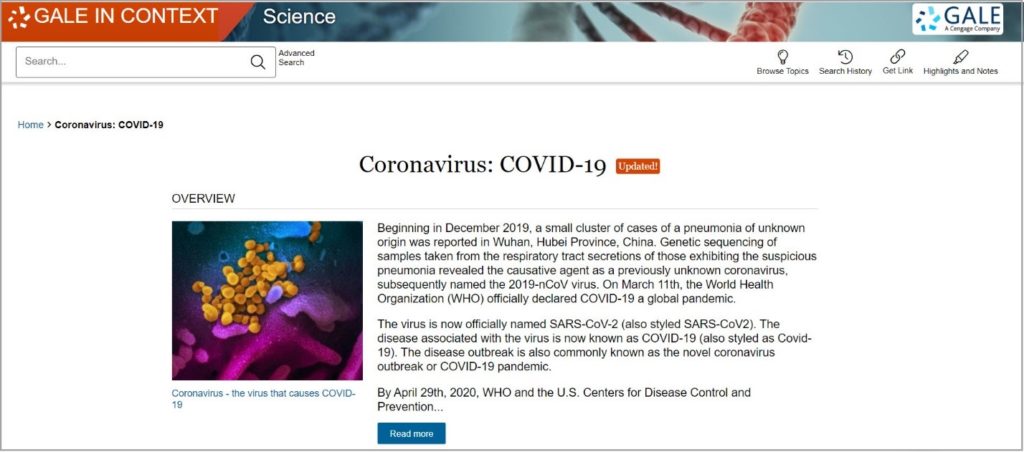| By K. Lee Lerner |
In response to the COVID-19 pandemic, governments, pharmaceutical companies, and teams of scientists have invested heavily in the research and testing of potential vaccines.1
From foundational molecular analysis of the novel and highly infectious SARS-CoV-2 coronavirus (COVID-19) to advanced clinical trials of vaccines to ensure that they are both effective and safe, scientists have gathered and published an unprecedented amount of journal articles and data on the virus and the human immune response to it.
As of early September 2020, three vaccines, two in China and one in Russia, were conditionally approved for early or limited use in humans. By U.S. standards, based on a process of phased clinical testing, the Chinese and Russian vaccines weren’t yet considered effective or safe because they hadn’t finished advanced clinical trials, nor had data from such trials been subject to peer review.
The vaccine approval process generally moves from preclinical testing through Phase I, II, and III human clinical trials.
Preclinical research tests determine whether a candidate vaccine produces an immune response in human cells and in animal trials (usually mice and/or monkeys). According to the New York Times, by early September 2020, over 90 candidate vaccines were in preclinical testing.2
Phase I clinical testing consists of tests on small groups of human volunteers to confirm that the candidate vaccine elicits an antibody response in humans, determine the proper dosing, and discover whether any side effects manifest.
Phase II clinical trials expand on Phase I trials by continuing to test for effectiveness. Phase II monitors for side effects in a larger pool of human volunteers that have been selected to represent a diversity of demographic groups, to determine if the vaccine works effectively and safely across population subgroups.
Phase III clinical efficacy trials (also called double-blind, randomized clinical trials) are the gold standard for testing and provide the most reliable data. Phase III trials continue to test for vaccine effectiveness and safety, but in a much larger pool of people, typically 10,000 to 40,000 test subjects. Phase III testing includes groups of test subjects that receive a placebo instead of the candidate vaccine. Double blind means that during testing, neither the administrator of the vaccine nor the recipient knows whether a particular test subject receives a candidate vaccine or a placebo. A placebo arm of a study allows researchers to compare outcomes of those who receive the candidate vaccine directly against those who don’t receive it. Phase III trials are also designed to be large enough to spot relatively rare side effects.
To speed up the testing process, especially in response to the COVID-19 pandemic, researchers may combine phases of clinical trials—typically Phase I and Phase II trials. Accordingly, a vaccine may be in multiple stages of testing. Testing in a particular phase may also be interrupted if test subjects develop side effects. On Wednesday, September 9, 2020, for example, AstraZeneca halted its Phase III candidate vaccine trials to investigate possible side effects in a test subject.
In general, the most common vaccine effects encountered across a range of typically administered vaccines are mild fevers and/or rashes. In a few cases, side effects can be more severe; however, for tested and approved vaccines, serious side effects are rare.
According to the New York Times, as of September 9, approximately 37 vaccines were in some stage of human clinical testing.3
In the United States, the U.S. Food and Drug Administration (FDA) Center for Biologics Evaluation and Research is responsible for regulating vaccines. Standards vary for clinical use approval, but in the United States the FDA requires that, to be determined effective, a candidate vaccine must prevent disease or lower (mitigate) disease symptoms in at least 50 percent of those who receive it.
Historically, most candidate vaccines fail to meet the standards imposed by a rigorous testing and peer review process, and so aren’t approved for wide distribution. The time required for successful vaccines to gain approval normally ranges from 4 to 12 years.
By the end of August 2020, both China and Russia were administering vaccines that hadn’t yet completed Phase III trials to essential workers. Russian President Vladimir Putin declared victory in the international COVID-19 vaccine race, with a vaccine dubbed “Sputnik-V,” in honor of the first artificial satellite launched into space in 1957 by Russia, when it was part of the now-disbanded Soviet Union. The COVID-19 vaccine, also called the Gamaleya vaccine after the Russian Ministry of Health research institute that developed it, was based on a harmless virus that, when injected, expresses a protein produced by SARS-CoV-2 that stimulates the production of antibodies.
The international community expressed immediate skepticism to the Russian claims because only 76 people were tested (38 in Phase I and 38 in Phase II trials), a number far too small to draw statistically valid results. In early September, however, the Russians announced that Sputnik-V/Gamaleya recipients were showing “mild side effects,” and that the current approval for the vaccine’s use was only tentative, pending further Phase III trials.
In the United States, the Trump administration’s effort to rapidly accelerate the development of a COVID-19 vaccine was named Operation Warp Speed (OWS).4 With approximately a billion dollars quickly invested in basic research, clinical trials, and the development of infrastructure to distribute a vaccine once approved, the program has become one of the most ambitious scientific undertakings in U.S. history.
The OWS effort isn’t without scientific criticism, which is centered mainly on a lack of transparency about the selection and funding of candidate vaccines being developed by private industry. The development of a vaccine has also taken on political ramifications for the 2020 U.S. presidential election. According to a STAT-Harris survey in September 2020, “82 percent of Democrats and 72 percent of Republicans expressed concern that the COVID-19 vaccine approval process would be driven more by politics than by science.”
To guard against public perception that the approval and release of a candidate vaccine for general use are politically motivated, in September 2020, a group of major pharmaceutical companies developing candidate vaccines released a statement and pledge to only produce and distribute COVID-19 vaccines after they were proven safe and effective.
To find the latest news and journal articles on COVID-19 and its vaccine development, go to our Gale In Context: Science Coronavirus: COVID-19 topic page.

Not a Gale In Context: Science subscriber? Learn more today!
1. Lerner, K. Lee, and Brenda Wilmoth Lerner. “Novel coronavirus outbreak (Covid-19).” In Gale Science Online Collection. Detroit, MI: Gale, 2020. Gale In Context: Science (accessed September 17, 2020).
2. Carl Zimmer and Katie Thomas, “What We Know About the C.D.C.’s Covid-19 Vaccine Plans,” New York Times, September 16, 2020.
3. The New York Times. “Coronavirus Vaccine Tracker.” (accessed September 5, 2020)
4. Nicole Daniels, “How Should We Balance Safety and Urgency in Developing a Covid-19 Vaccine?” New York Times, September 9, 2020.
5. “Operation Warp Speed Top Adviser on the Status of a Coronavirus Vaccine.” All Things Considered, September 3, 2020, NA. Gale In Context: Science (accessed September 17, 2020).
Meet the Author
K. Lee Lerner is a writer, editor, and aviator who, along with Brenda Wilmoth Lerner, is the editor of the Gale Encyclopedia of Espionage, Intelligence, and Security; Climate Change: In Context; and many other award-winning books and articles on science, technology, and a range of global issues. He also serves as the scientific advisor for Gale In Context: Science. A full bio and list of his work may be found at scholar.harvard.edu/kleelerner and harvard.academia.edu/KLeeLerner/.
Wholesale Cheap Nike, Jordans, Adidas, Air Max Shoes China Sale Online

